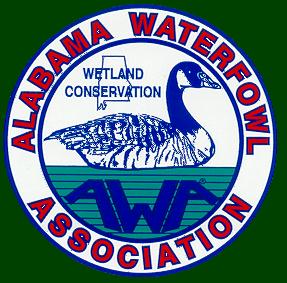
AWA Biologist Report
This report is written by & submitted by Gary Ervin. Gary is a National Science Foundation Graduate Research Fellow at the University of Alabama. This is the first of many reports that Gary will submit to the AWA. I hope that you find this both educational and enjoyable. - Webmaster
Diet and Nutrition of North American Ducks and Geese
Most of us are familiar with the division among ducks between dabbling and diving ducks, and that many diving ducks have a tendency towards consuming underwater animal life. Probably less familiar are the forces regulating diet selection during the annual cycle of waterfowl and the degree of similarity in diet and nutrition among the different species of ducks and geese.
Before examining annual changes in waterfowl diet, we should take a look at the composition of various foods, as this is important in understanding why diet changes throughout the year. In general, we can consider three components of waterfowl food: protein, which is used for building tissues, and fat and carbohydrates, which are used for energy. Consumption of each component is important throughout the year, but the relative importance varies considerably.
Protein in body tissues is replaced at a rate of about 4 to 5% per day, on average. Animals are capable of building some of the twenty basic amino acids (protein "building blocks") on their own, while others must be acquired from external sources. Because different proteins can have different amino acid composition, waterfowl often may consume a variety of protein-rich foods at times of the year when protein is most crucial.
Although both fat and carbohydrates are used for energy, there are differences between the two. Carbohydrates, for instance, are an excellent source of energy, but are burned up quite rapidly in active waterfowl. However, when the birds are less active, excess carbohydrates can be converted to fat for storage. Hence, fat is used primarily as a warehouse for food energy. Once available carbohydrates are used up, fat can quickly be mobilized as an energy source.
The percentage of each of these three food components varies widely among waterfowl foods. Fat is the least variable of these three, making up about 2 to 15% of plant foods and from 2 to 10% of animal foods. In plant foods, carbohydrates are frequently most available. For instance, most agricultural grains are made up of 55 to 80% carbohydrate. Natural wetland plant seeds are more variable and range from about 30% to near 70% carbohydrate. Among natural plants, grasses and sedges provide the most energy-rich seeds. Additionally, the below-ground portions of natural wetland plants (roots, tubers, rhizomes) often are made up of 55 to 75% carbohydrate.
While aquatic animals are much lower in carbohydrates (2 to 15% of dry mass), they are enriched in protein, compared to plants. On the low end of the animal protein scale, aquatic snails typically are about 20% or less protein. Insects on the other hand, particularly the larval forms, may have a protein content of up to 75%. In comparison, plant parts range from about 10 to 20% protein, with a few examples up to 25 to 30%. The few legumes (beans, peas) consumed by waterfowl often have much higher protein content than naturally-available plant foods. Soybeans, for example, are about 35% protein.
With such variation in the nutrition of available foods, what determines which foods will be consumed? Beyond availability, food selection is largely determined by the activities in which waterfowl are engaged. Birds that are preparing for migration require a lot of energy, so they will choose fat- and carbohydrate-rich foods, such as plant seeds and rooting tissues. During the breeding season, food selection will change to foods rich in proteins, in preparation for laying eggs. For example, the diet of wintering ducks may be comprised of more than 90% plant material, while laying females might eat a diet of up to 99% invertebrate animals.
Although these trends of energy vs. protein consumption are relatively common among all waterfowl, there are differences in the types of foods used for each purpose. Most ducks (puddle ducks and divers) consume a mixed diet of plant and animal materials. During the breeding season, the diet is composed primarily of animals. Among the animals eaten are : insects (e.g., midges, mosquitoes, beetles, damselflies, and mayflies), crustaceans (waterfleas, freshwater shrimp) and aquatic snails. During the winter, however, the diet switches to plant materials, among these are agricultural foods (corn, soybeans, rice) and natural wetland plants (seeds, leaves, and underground tissues).
Geese, on the other hand, consume primarily plant materials. During the winter, this is largely agricultural grain, supplemented with seeds, leaves, and underground portions of wild plants. Some geese may consume up to 80% or more of their diet as agricultural crops, where these are available in excess. In areas where crops are not so available, natural wetland plants make up 65% or more of the diet. During the breeding season, geese switch from seeds and underground tissues, which are rich in carbohydrates, to leaves and stems in order to get the protein needed for reproduction.
In short, although waterfowl are a diverse group of animals, there are definite trends shared by all species in regard to the annual changes in food selection. Actual choice of individual foods is influenced both by the species' feeding adaptations (, dabblers vs. divers) and by food availability. This second factor, especially with respect to protein acquisition, is regulated to a large extent by the presence of sufficient acreage of wetland habitats for aquatic plant and invertebrate production. So keep conserving wetlands!